Underwater Noise Monitoring with Real-Time and Low-Cost Systems, (The CORMA Experience)
Abstract
:1. Introduction
1.1. Objectives
1.2. The Development Path
2. Materials and Methods
2.1. The Monitoring System
2.2. The Deployment Area
2.3. The Observatory Platform
2.4. Data Processing and Web Based Visualization
3. Results
3.1. System Performance Results
3.2. First Monitoring Results
4. Discussion
5. Conclusions
Author Contributions
Funding
Institutional Review Board Statement
Informed Consent Statement
Data Availability Statement
Acknowledgments
Conflicts of Interest
References
- Codarin, A.; Picciulin, M. Underwater noise assessment in the Gulf of Trieste (Northern Adriatic Sea, Italy) using an MSFD approach. Mar. Pollut. Bull. 2015, 101, 694–700. [Google Scholar] [CrossRef] [PubMed]
- Chou, E.; Southall, B.L.; Robards, M.; Rosenbaum, H.C. International policy, recommendations, actions and mitigation efforts of anthropogenic underwater noise. Ocean Coast. Manag. 2021, 202, 105427. [Google Scholar] [CrossRef]
- European Parliament and Council. Directive 2008/56/EC of the European Parliament and of the Council of 17 June 2008 Establishing a Framework for Community Action in the Field of Marine Environmental Policy (Marine Strategy Framework Directive) (Text with EEA Relevance). 2008. Available online: https://eur-lex.europa.eu/legal-content/EN/TXT/?uri=CELEX:32008L0056 (accessed on 6 April 2021).
- Popper, A.; Hastings, M. The effects of anthropogenic sources of sound on fishes. J. Fish Biol. 2009, 75, 455–489. [Google Scholar] [CrossRef] [PubMed]
- Boehlert, G.; Gill, A. Environmental and Ecological Effects of Ocean Renewable Energy Development—A Current Synthesis. Oceanography 2010, 23, 68–81. [Google Scholar] [CrossRef] [Green Version]
- Sarà, G.; Dean, J.M.; D’Amato, D.; Buscaino, G.; Oliveri, A.; Genovese, S.; Ferro, S.; Buffa, G.; Lo Martire, M.; Mazzola, S. Marine Ecology Progress Series 331:243. Mar. Ecol. Prog. Ser. 2007, 331, 243–253. [Google Scholar] [CrossRef] [Green Version]
- Thomsen, F.; Campbell, J.; Fredheim, B.; Unger, S.; Ashe, S.; Middleton, B. Overview of the Impacts of Anthropogenic Underwater Sound in the Marine Environment. OSPAR Commission Report. 2009. Available online: https://www.ospar.org/documents?v=7147 (accessed on 6 April 2021).
- Vasconcelos, R.O.; Amorim, M.C.P.; Ladich, F. Effects of ship noise on the detectability of communication signals in the Lusitanian toadfish. J. Exp. Biol. 2007, 210, 2104–2112. [Google Scholar] [CrossRef] [Green Version]
- Codarin, A.; Wysocki, L.E.; Ladich, F.; Picciulin, M. Effects of ambient and boat noise on hearing and communication in three fish species living in a marine protected area (Miramare, Italy). Mar. Pollut. Bull. 2009, 58, 1880–1887. [Google Scholar] [CrossRef]
- Hawkins, A.D. Examining Fish in the Sea: A European Perspective on Fish Hearing Experiments. In Perspectives on Auditory Research; Popper, A.N., Fay, R.R., Eds.; Springer: New York, NY, USA, 2014; Volume 50, pp. 247–267. [Google Scholar]
- Robinson, S.P.; Wang, L.; Cheong, S.-H.; Lepper, P.A.; Marubini, F.; Hartley, J.P. Underwater acoustic characterisation of unexploded ordnance disposal using deflagration. Mar. Pollut. Bull. 2020, 160, 111646. [Google Scholar] [CrossRef]
- Hawkins, A.D.; Popper, A.N. A sound approach to assessing the impact of underwater noise on marine fishes and invertebrates. ICES J. Mar. Sci. 2016, 74, 635–651. [Google Scholar] [CrossRef]
- Southall, B.L.; Finneran, J.J.; Reichmuth, C.; Nachtigall, P.E.; Ketten, D.R.; Bowles, A.E.; Ellison, W.T.; Nowacek, D.P.; Tyack, P.L. Marine Mammal Noise Exposure Criteria: Updated Scientific Recommendations for Residual Hearing Effects. Aquat. Mamm. 2019, 45, 125–232. [Google Scholar] [CrossRef]
- Hildebrand, J.A. Anthropogenic and natural sources of ambient noise in the ocean. Mar. Ecol. Prog. Ser. 2009, 395, 5–20. [Google Scholar] [CrossRef] [Green Version]
- Erbe, C.; Reichmuth, C.; Cunningham, K.; Lucke, K.; Dooling, R. Communication masking in marine mammals: A review and research strategy. Mar. Pollut. Bull. 2016, 103, 15–38. [Google Scholar] [CrossRef] [PubMed]
- Tasker, M.L. Overview of regulations for the conservation and protection of organisms in European seas. Bioacoustics 2008, 17, 280–283. [Google Scholar] [CrossRef]
- Matthews, M.-N.R.; Ireland, D.S.; Zeddies, D.G.; Brune, R.H.; Pyć, C.D. A Modeling Comparison of the Potential Effects on Marine Mammals from Sounds Produced by Marine Vibroseis and Air Gun Seismic Sources. J. Mar. Sci. Eng. 2020, 9, 12. [Google Scholar] [CrossRef]
- Løkkeborg, S.; Ona, E.; Vold, A.; Salthaug, A. Sounds from seismic air guns: Gear- and species-specific effects on catch rates and fish distribution. Can. J. Fish. Aquat. Sci. 2012, 69, 1278–1291. [Google Scholar] [CrossRef]
- Mooney, A.; Andersson, M.; Stanley, J. Acoustic Impacts of Offshore Wind Energy on Fishery Resources: An Evolving Source and Varied Effects across a Wind Farm’s Lifetime. Oceanography 2020, 33, 82–95. [Google Scholar] [CrossRef]
- Halvorsen, M.B. Effects of Tidal Turbine Noise. p. 42. Available online: http://ww.ntis.gov/ordering.htm (accessed on 8 February 2021).
- Spandonidis, C.C.; Arvaniti, K. Numerical Modeling of the Exposure on Radiofrequency Radiation of Marine Mammal Observers during Their Shift: A Case Study. Int. J. Saf. Secur. Eng. 2020, 10, 753–758. [Google Scholar] [CrossRef]
- Erbe, C.; Marley, S.A.; Schoeman, R.P.; Smith, J.N.; Trigg, L.E.; Embling, C.B. The Effects of Ship Noise on Marine Mammals—A Review. Front. Mar. Sci. 2019, 6. [Google Scholar] [CrossRef] [Green Version]
- Frisk, G.V. Noiseonomics: The relationship between ambient noise levels in the sea and global economic trends. Sci. Rep. 2012, 2, 437. [Google Scholar] [CrossRef] [Green Version]
- Worldwide Ship Traffic up 300 Percent Since 1992, AGU Newsroom. Available online: https://news.agu.org/press-release/worldwide-ship-traffic-up-300-percent-since-1992/ (accessed on 8 February 2021).
- McDonald, M.A.; Hildebrand, J.A.; Wiggins, S.M.; Ross, D. A 50Year comparison of ambient ocean noise near San Clemente Island: A bathymetrically complex coastal region off Southern California. J. Acoust. Soc. Am. 2008, 124, 1985–1992. [Google Scholar] [CrossRef]
- Veirs, S.; Veirs, V.; Wood, J.D. Ship noise extends to frequencies used for echolocation by endangered killer whales. PeerJ 2016, 4, e1657. [Google Scholar] [CrossRef] [Green Version]
- Trevorrow, M.V.; Vasiliev, B.; Vagle, S. Directionality and maneuvering effects on a surface ship underwater acoustic signature. J. Acoust. Soc. Am. 2008, 124, 767–778. [Google Scholar] [CrossRef] [Green Version]
- Hovem, J.M. Ray Trace Modeling of Underwater Sound Propagation. In Modeling and Measurement Methods for Acoustic Waves and for Acoustic Microdevices; Beghi, M.G., Ed.; InTech: London, UK, 2013. [Google Scholar] [CrossRef] [Green Version]
- International Convention for the Safety of Life at Sea (SOLAS). 1974. Available online: https://www.imo.org/en/About/Conventions/Pages/International-Convention-for-the-Safety-of-Life-at-Sea-(SOLAS),-1974.aspx (accessed on 19 February 2021).
- Van der Graaf, A.J.; Ainslie, M.A.; André, M.; Brensing, K.; Dalen, J.; Dekeling, R.P.A.; Robinson, S.; Tasker, M.L.; Thomsen, F.; Werner, S. European Marine Strategy Framework Directive Good Environmental Status (MSFD-GES) Report of the Technical Sub-group on Underwater Noise and other forms of energy. EC 2012. Available online: https://circabc.europa.eu/sd/a/4c365582-ff92-42d0-bf25-0f30e1f9c1db/MSFD%20Final%20report%20of%20the%20TSG%20Noise%20feb2012.pdf (accessed on 6 April 2021).
- Lara, G.; Miralles, R.; Bou-Cabo, M.; Esteban, J.A.; Espinosa, V. New Insights into the Design and Application of a Passive Acoustic Monitoring System for the Assessment of the Good Environmental Status in Spanish Marine Waters. Sensors 2020, 20, 5353. [Google Scholar] [CrossRef] [PubMed]
- Van Parijs, S.M.; Clark, C.W.; Sousa-Lima, R.S.; Parks, S.E.; Rankin, S.; Risch, D.; Van Opzeeland, I.C. Management and research applications of real-time and archival passive acoustic sensors over varying temporal and spatial scales. Mar. Ecol. Prog. Ser. 2009, 395, 21–36. [Google Scholar] [CrossRef] [Green Version]
- Hayes, S.A.; Mellinger, D.K.; Croll, D.A.; Costa, D.P.; Borsani, J.F. An inexpensive passive acoustic system for recording and localizing wild animal sounds. J. Acoust. Soc. Am. 2000, 107, 3552–3555. [Google Scholar] [CrossRef] [PubMed]
- Pieretti, N.; Martire, M.L.; Corinaldesi, C.; Musco, L.; Dell’Anno, A.; Danovaro, R. Anthropogenic noise and biological sounds in a heavily industrialized coastal area (Gulf of Naples, Mediterranean Sea). Mar. Environ. Res. 2020, 159, 105002. [Google Scholar] [CrossRef] [PubMed]
- Wiggins, S.M.; Hildebrand, J.A. High-frequency Acoustic Recording Package (HARP) for broad-band, long-term marine mammal monitoring. In Proceedings of the 2007 Symposium on Underwater Technology and Workshop on Scientific Use of Submarine Cables and Related Technologies, Tokyo, Japan, 17–20 April 2007; IEEE: Piscataway, NJ, USA, 2007; pp. 551–557. [Google Scholar]
- Haver, S.M.; Gedamke, J.; Hatch, L.T.; Dziak, R.P.; Van Parijs, S.; McKenna, M.F.; Barlow, J.; Berchok, C.; DiDonato, E.; Hanson, B.; et al. Monitoring long-term soundscape trends in U.S. Waters: The NOAA/NPS Ocean Noise Reference Station Network. Mar. Policy 2018, 90, 6–13. [Google Scholar] [CrossRef]
- Moran, K.; Boutin, B.; Juniper, S.K.; Pirenne, B.; Round, A. A multi-use and multi-stakeholder ocean observing platform system. In Proceedings of the OCEANS 2019 MTS/IEEE SEATTLE, Seattle, WA, USA, 27–31 October 2019; IEEE: Piscataway, NJ, USA, 2019; pp. 1–5. [Google Scholar]
- Adam, O.; Glotin, H. Passive acoustic storey of the Antares neutrino detector for real-time cetaceans detection, localization and behavior studies. In Proceedings of the 2008 New Trends for Environmental Monitoring Using Passive Systems, Hyeres, France, 14–17 October 2008; Institute of Electrical and Electronics Engineers (IEEE): Piscataway, NJ, USA, 2008; pp. 1–6. [Google Scholar]
- Favali, P.; Chierici, F.; Marinaro, G.; Giovanetti, G.; Azzarone, A.; Beranzoli, L.; De Santis, A.; Embriaco, D.; Monna, S.; Bue, N.L.; et al. NEMO-SN1 Abyssal Cabled Observatory in the Western Ionian Sea. IEEE J. Ocean. Eng. 2013, 38, 358–374. [Google Scholar] [CrossRef]
- Sanguineti, M.; Alessi, J.; Brunoldi, M.; Cannarile, G.; Cavalleri, O.; Cerruti, R.; Falzoi, N.; Gaberscek, F.; Gili, C.; Gnone, G.; et al. An automated passive acoustic monitoring system for real time sperm whale (Physeter macrocephalus) threat prevention in the Mediterranean Sea. Appl. Acoust. 2021, 172, 107650. [Google Scholar] [CrossRef]
- Hu, C.; Pu, Y.; Yang, F.; Zhao, R.; Alrawais, A.; Xiang, T. Secure and Efficient Data Collection and Storage of IoT in Smart Ocean. IEEE Internet Things J. 2020, 7, 9980–9994. [Google Scholar] [CrossRef]
- Climent, S.; Sanchez, A.; Capella, J.V.; Meratnia, N.; Serrano, J.J. Underwater Acoustic Wireless Sensor Networks: Advances and Future Trends in Physical, MAC and Routing Layers. Sensors 2014, 14, 795–833. [Google Scholar] [CrossRef] [PubMed]
- Ajemian, M.J.; Lamboy, C.; Ibrahim, A.; DeGroot, B.C.; Bassos-Hull, K.; Mann, D.A.; Chérubin, L. Capturing shell-crushing by large mobile predators using passive acoustics technology. J. Exp. Mar. Biol. Ecol. 2021, 535, 151497. [Google Scholar] [CrossRef]
- SoX. Available online: http://sox.sourceforge.net/sox.html (accessed on 16 March 2021).
- Cibic, T.; Franzo, A.; Nasi, F.; Auriemma, R.; Del Negro, P. The Port of Trieste (Northern Adriatic Sea)—A Case Study of the “Ecosystem Approach to Management. Front. Mar. Sci. 2017, 4. [Google Scholar] [CrossRef] [Green Version]
- Cosoli, S.; Ličer, M.; Vodopivec, M.; Malačič, V. Surface circulation in the Gulf of Trieste (northern Adriatic Sea) from radar, model, and ADCP comparisons. J. Geophys. Res. Oceans 2013, 118, 6183–6200. [Google Scholar] [CrossRef]
- Cozzi, S.; Falconi, C.; Comici, C.; Čermelj, B.; Kovac, N.; Turk, V.; Giani, M. Recent evolution of river discharges in the Gulf of Trieste and their potential response to climate changes and anthropogenic pressure. Estuar. Coast. Shelf Sci. 2012, 115, 14–24. [Google Scholar] [CrossRef]
- Ogorelec, B.; Mišič, M.; Faganeli, J. Marine geology of the Gulf of Trieste (northern Adriatic): Sedimentological aspects. Mar. Geol. 1991, 99, 79–92. [Google Scholar] [CrossRef]
- Trobec, A.; Busetti, M.; Zgur, F.; Baradello, L.; Babich, A.; Cova, A.; Gordini, E.; Romeo, R.; Tomini, I.; Poglajen, S.; et al. Thickness of marine Holocene sediment in the Gulf of Trieste (northern Adriatic Sea). Earth Syst. Sci. Data 2018, 10, 1077–1092. [Google Scholar] [CrossRef] [Green Version]
- Falcieri, F.M.; Kantha, L.; Benetazzo, A.; Bergamasco, A.; Bonaldo, D.; Barbariol, F.; Malačič, V.; Sclavo, M.; Carniel, S. Turbulence observations in the Gulf of Trieste under moderate wind forcing and different water column stratification. Ocean Sci. 2016, 12, 433–449. [Google Scholar] [CrossRef] [Green Version]
- Picciulin, M.; Bolgan, M.; Codarin, A.; Fiorin, R.; Zucchetta, M.; Malavasi, S. Passive acoustic monitoring of Sciaena umbra on rocky habitats in the Venetian littoral zone. Fish. Res. 2013, 145, 76–81. [Google Scholar] [CrossRef]
- Genov, T.; Kotnjek, P.; Centrih, T. Occurrence of common dolphins (Delphinus delphis) in the Gulf of Trieste and the northern Adriatic Sea. Aquat. Conserv. Mar. Freshw. Ecosyst. 2020. [Google Scholar] [CrossRef]
- Kralj, M.; Lipizer, M.; Čermelj, B.; Celio, M.; Fabbro, C.; Brunetti, F.; Francé, J.; Mozetič, P.; Giani, M. Hypoxia and dissolved oxygen trends in the northeastern Adriatic Sea (Gulf of Trieste). Deep. Sea Res. Part II Top. Stud. Oceanogr. 2019, 164, 74–88. [Google Scholar] [CrossRef]
- Welch, P. The use of fast Fourier transform for the estimation of power spectra: A method based on time averaging over short, modified periodograms. IEEE Trans. Audio Electroacoust. 1967, 15, 70–73. [Google Scholar] [CrossRef] [Green Version]
- Diviacco, P.; Firetto Carlino, M.; Busato, A. Enhancing the value of public vintage seismic data in the Italian offshore. Geosci. Data J. 2019, 6, 6–15. [Google Scholar] [CrossRef]
- Diviacco, P. On formalization and representation in collaborative research. In Dynamic Knowledge Representation in Scientific Domains; IGI Global: Hershey, PA, USA, 2018; pp. 89–97. [Google Scholar] [CrossRef]
- CORMA. Available online: https://corma.inogs.it (accessed on 28 March 2021).
- IEC 60565-1:2020 | IEC Webstore. Available online: https://webstore.iec.ch/publication/32074 (accessed on 4 March 2021).
- Slater, W.H.; Crocker, S.E.; Baker, S.R. A primary method for the complex calibration of a hydrophone from 1 Hz to 2 kHz. Metrologia 2017, 55, 84–94. [Google Scholar] [CrossRef]
- Theobald, P.D.; Robinson, S.P.; Thompson, A.D.; Preston, R.C.; Lepper, P.A.; Yuebing, W. Technique for the calibration of hydrophones in the frequency range 10 to 600 kHz using a heterodyne interferometer and an acoustically compliant membrane. J. Acoust. Soc. Am. 2005, 118, 3110–3116. [Google Scholar] [CrossRef] [Green Version]
- Robinson, S.P.; Theobald, P.D.; Foote, K.G. Calibration of hydrophones and electroacoustic transducers: A contribution to the OES standards initiative. In Proceedings of the OCEANS 2014, Taipei, Taiwan, 7–10 April 2014; pp. 1–5. [Google Scholar] [CrossRef]
- Benadí, A.G.; Cadena-Munoz, J.; Fernandez, J.D.R.; Juan, X.R.; Manuel-Làzaro, A. Good Practice Guide for calibrating a hydrophone “in situ” with a non-omnidirectional source at 10 kHz. Acta IMEKO 2015, 4, 26. [Google Scholar] [CrossRef]
- ISO. ISO/PAS 19450:2015: Automation Systems and Integration—Object-Process Methodology. Available online: https://www.iso.org/obp/ui/#iso:std:iso:pas:19450:ed-1:v1:en (accessed on 6 April 2021).
- Leon-Lopez, B.; Romero-Vivas, E.; Viloria-Gomora, L. Reduction of roadway noise in a coastal city underwater soundscape during COVID-19 confinement. J. Acoust. Soc. Am. 2021, 149, 652–659. [Google Scholar] [CrossRef]
- Miralles, R.; Lara, G.; Gosalbez, J.; Bosch, I.; León, A. Improved visualization of large temporal series for the evaluation of good environmental status. Appl. Acoust. 2019, 148, 55–61. [Google Scholar] [CrossRef]
- Buscaino, G.; Ceraulo, M.; Pieretti, N.; Corrias, V.; Farina, A.; Filiciotto, F.; Maccarrone, V.; Grammauta, R.; Caruso, F.; Alonge, G.; et al. Temporal patterns in the soundscape of the shallow waters of a Mediterranean marine protected area. Sci. Rep. 2016, 6, 34230. [Google Scholar] [CrossRef] [Green Version]
- Haxel, J.H.; Dziak, R.P.; Matsumoto, H. Observations of shallow water marine ambient sound: The low frequency underwater soundscape of the central Oregon coast. J. Acoust. Soc. Am. 2013, 133, 2586–2596. [Google Scholar] [CrossRef]
- Vozila, A.B.; Güttler, I.; Ahrens, B.; Obermann-Hellhund, A.; Prtenjak, M.T. Wind Over the Adriatic Region in CORDEX Climate Change Scenarios. J. Geophys. Res. Atmos. 2019, 124, 110–130. [Google Scholar] [CrossRef] [Green Version]
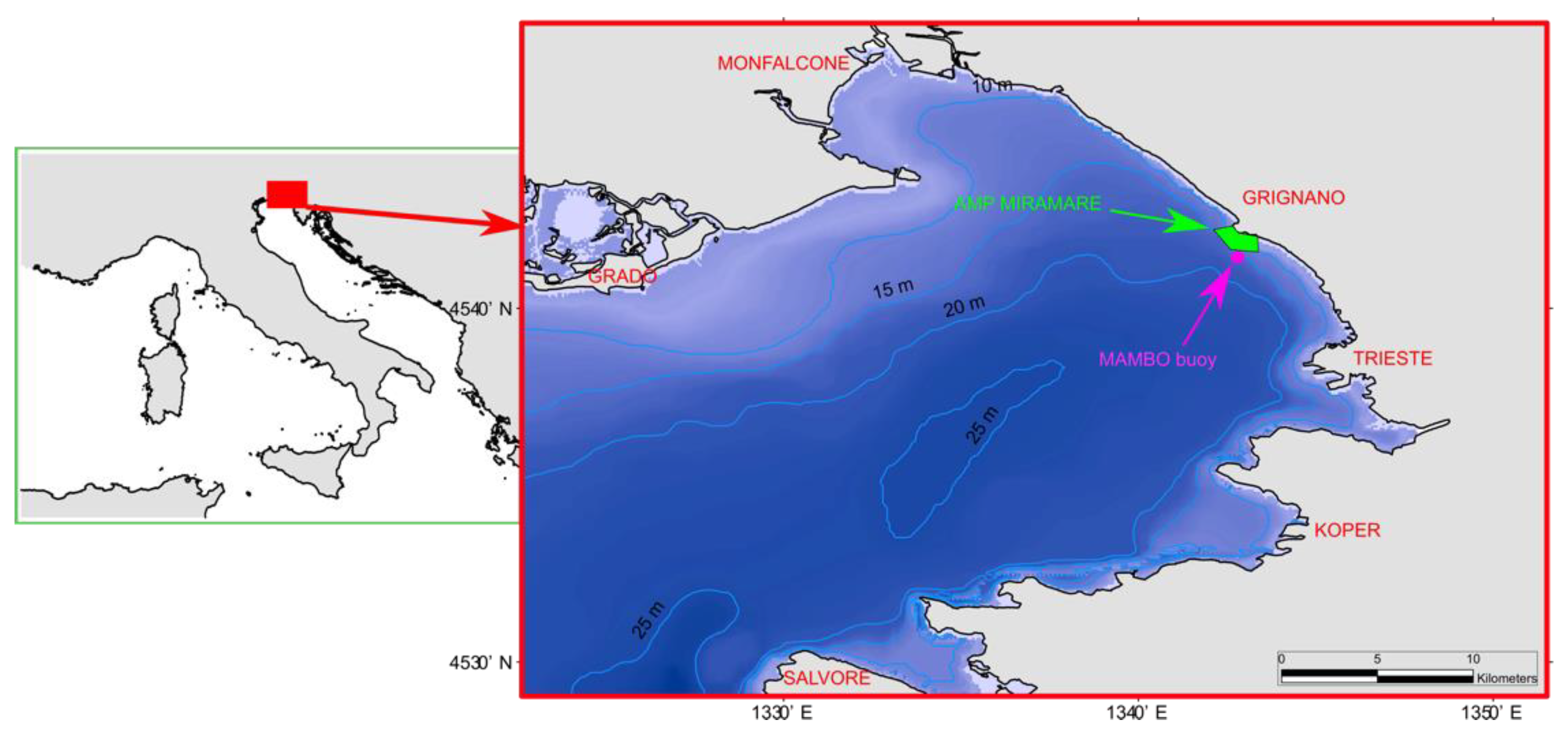
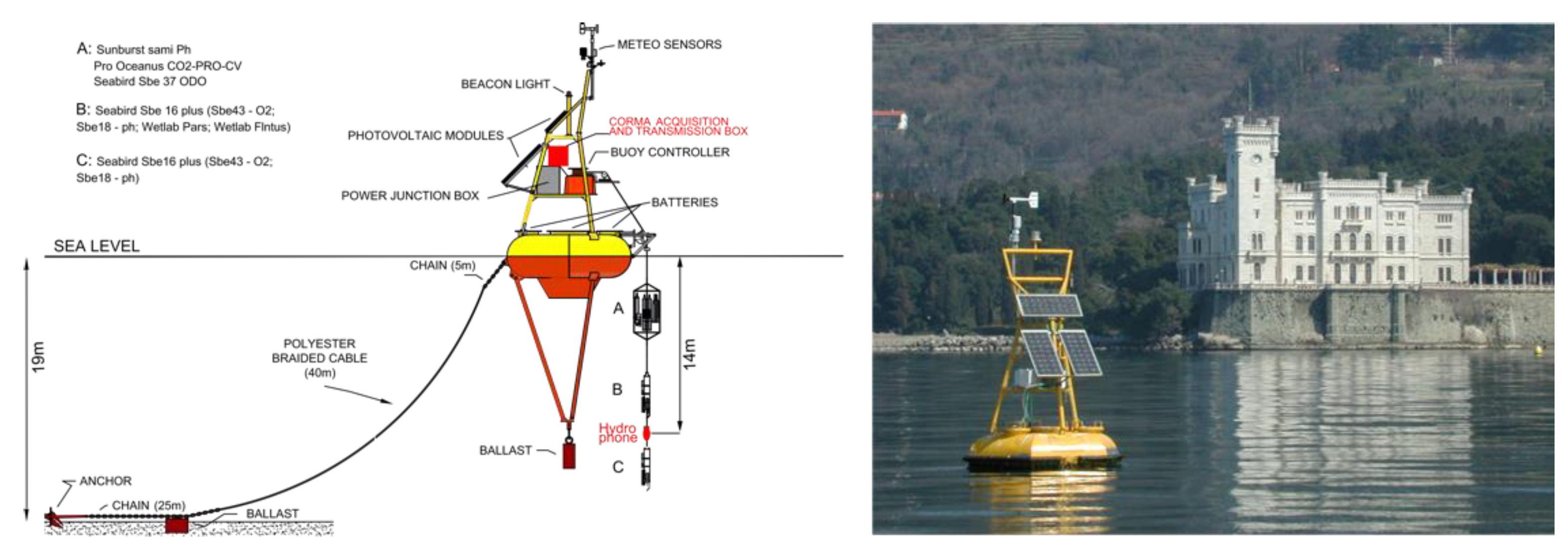
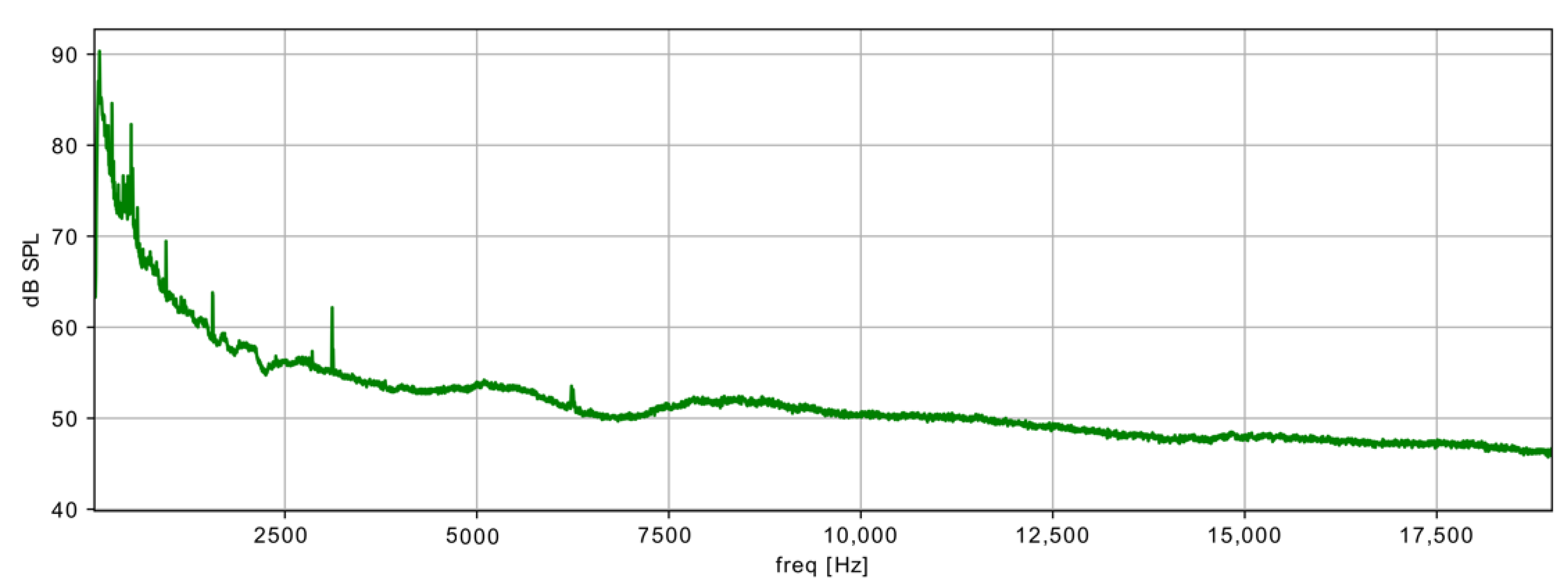
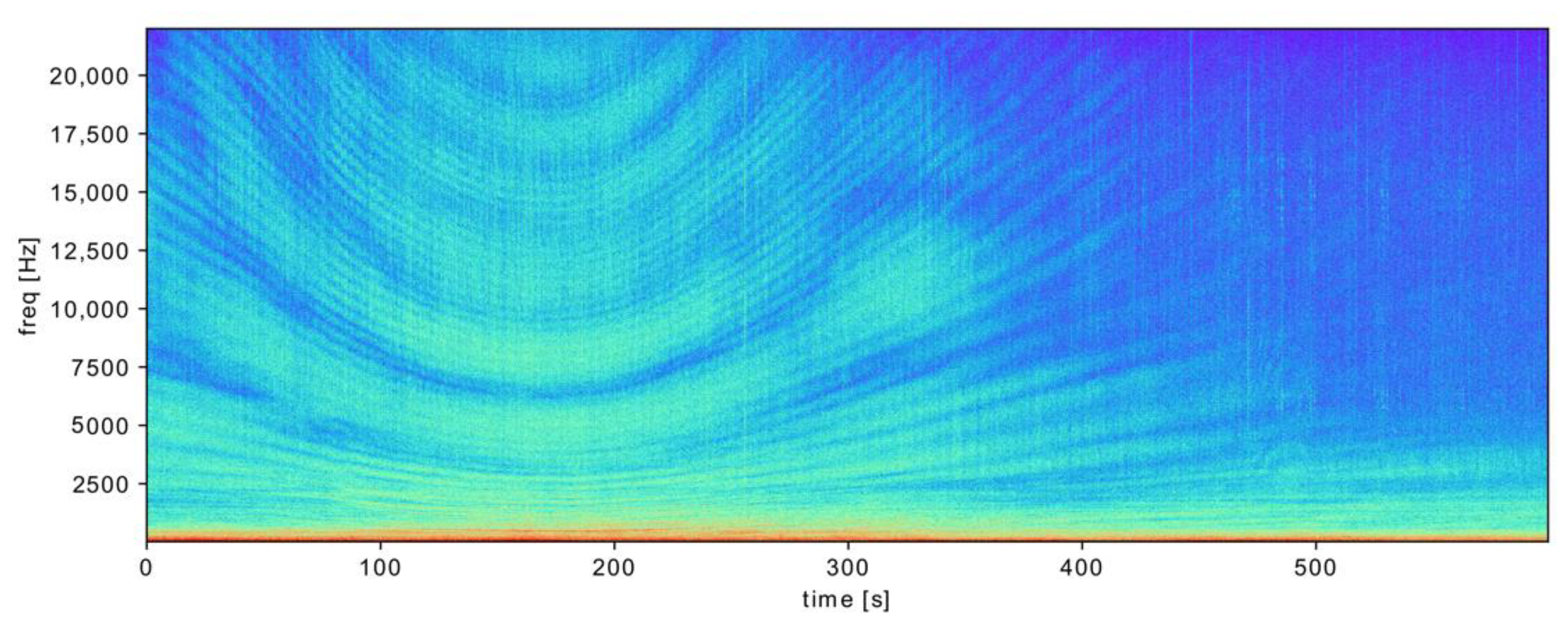
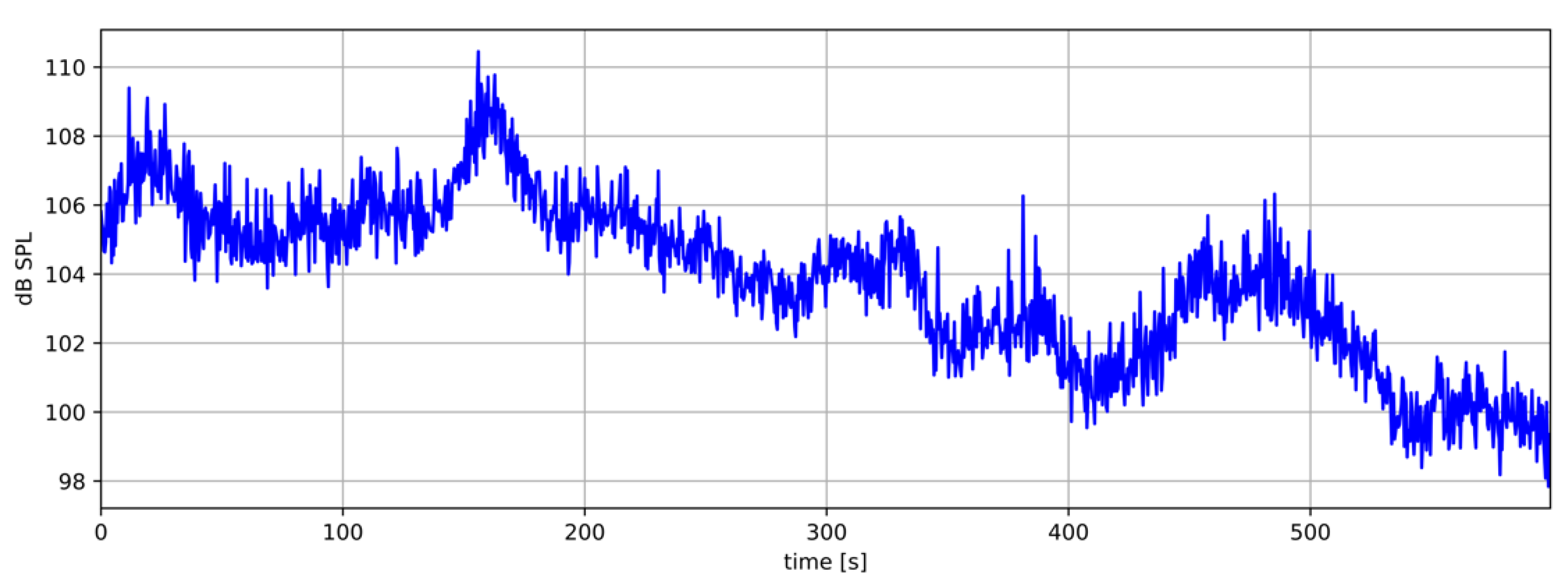

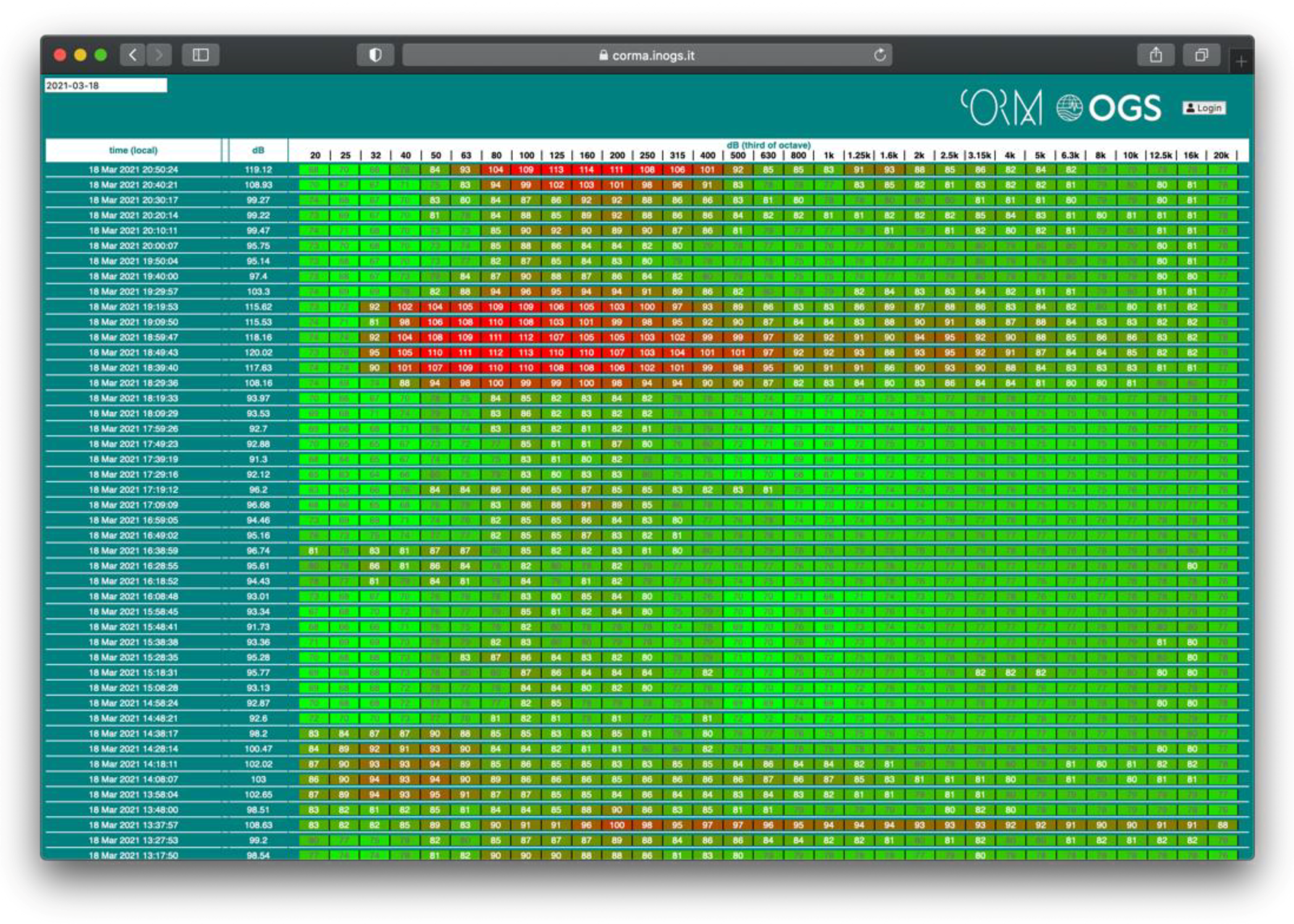
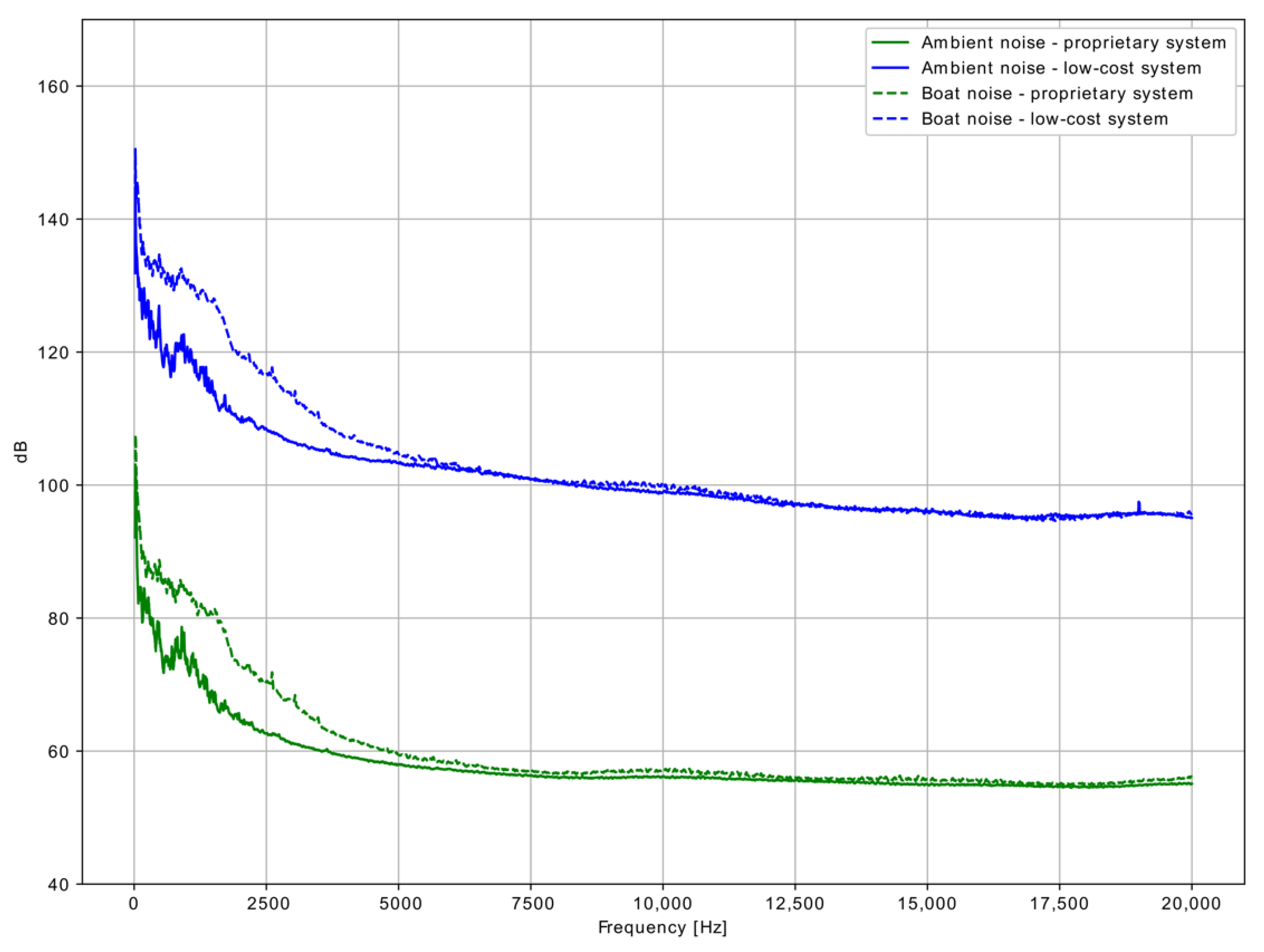
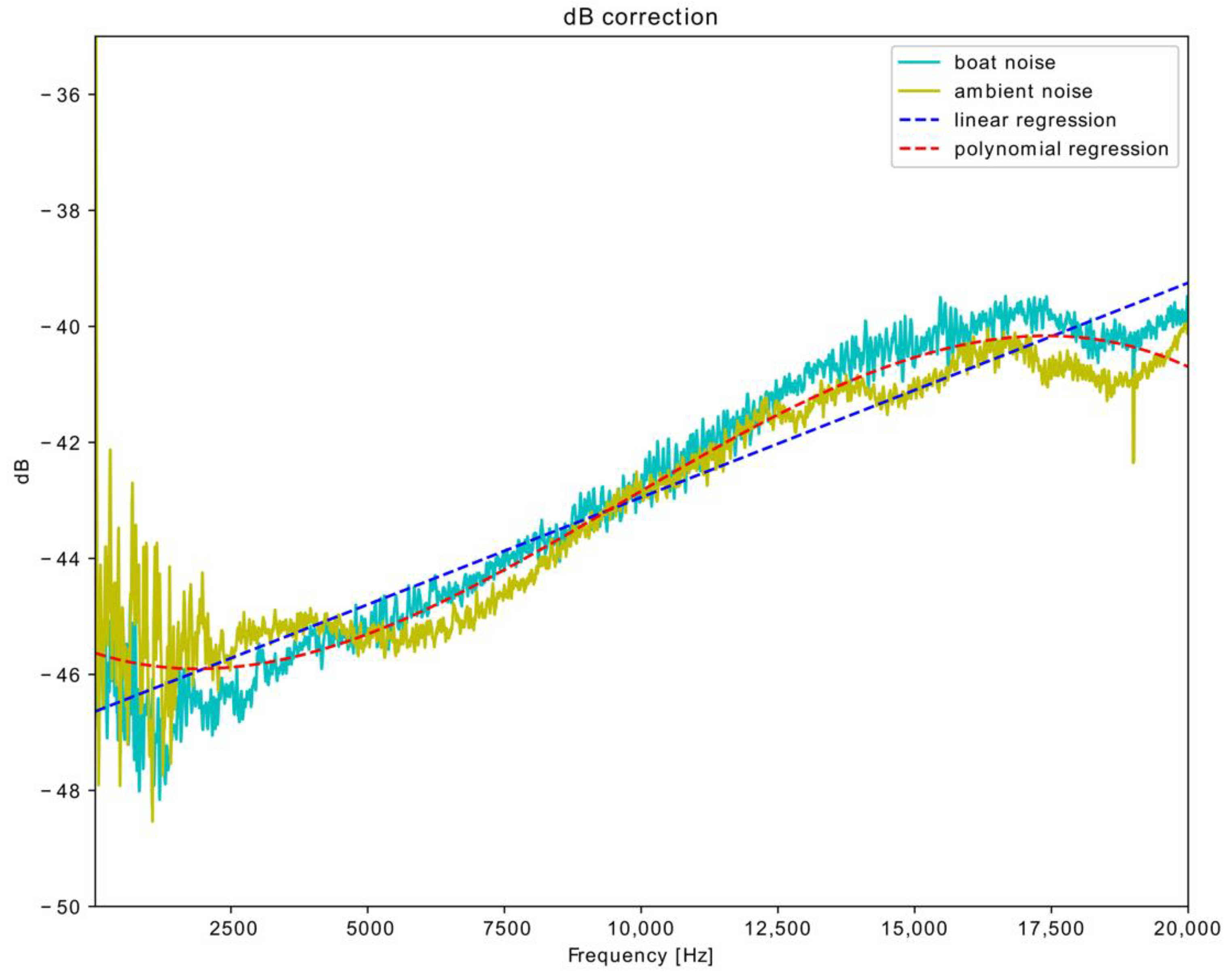

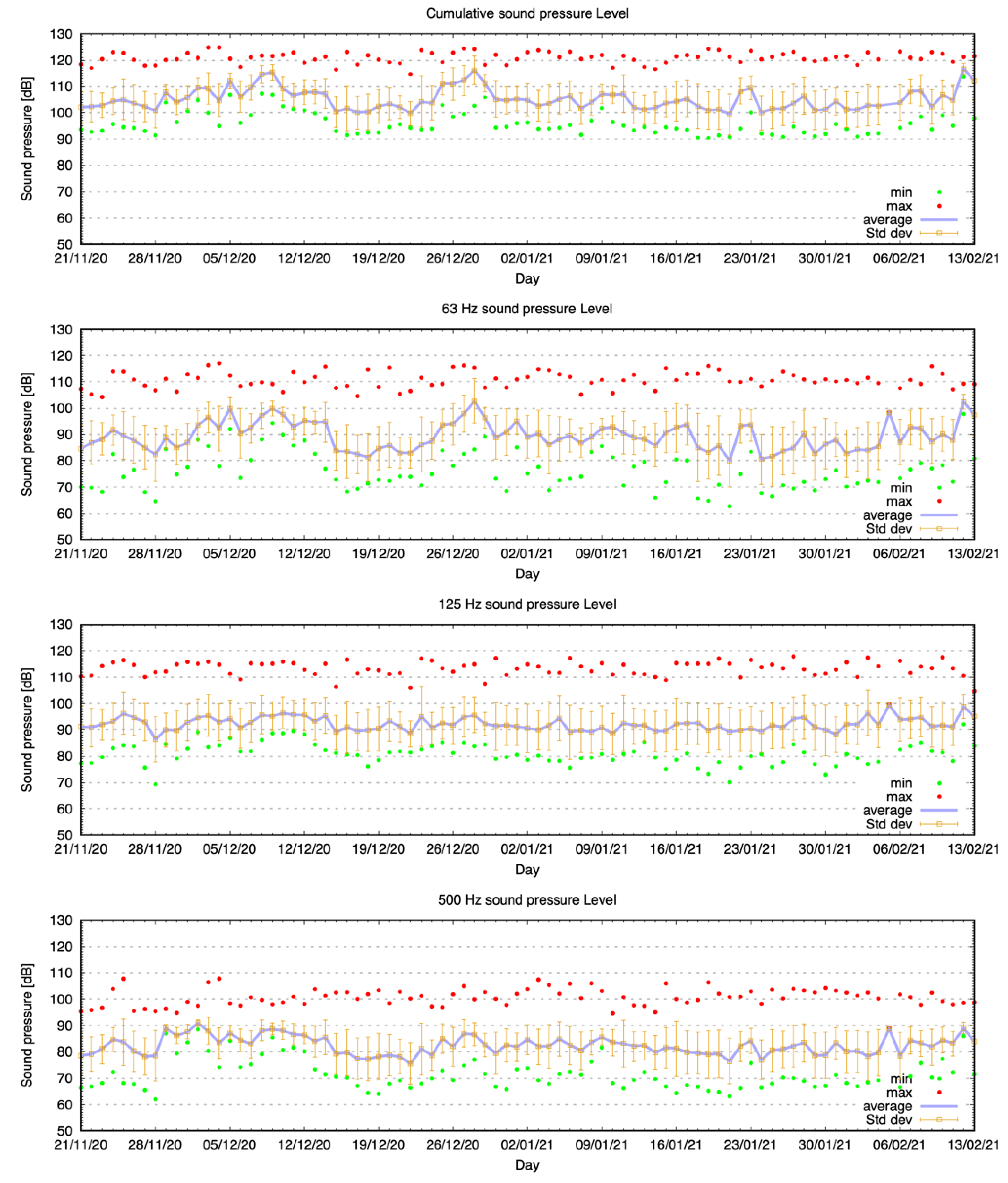

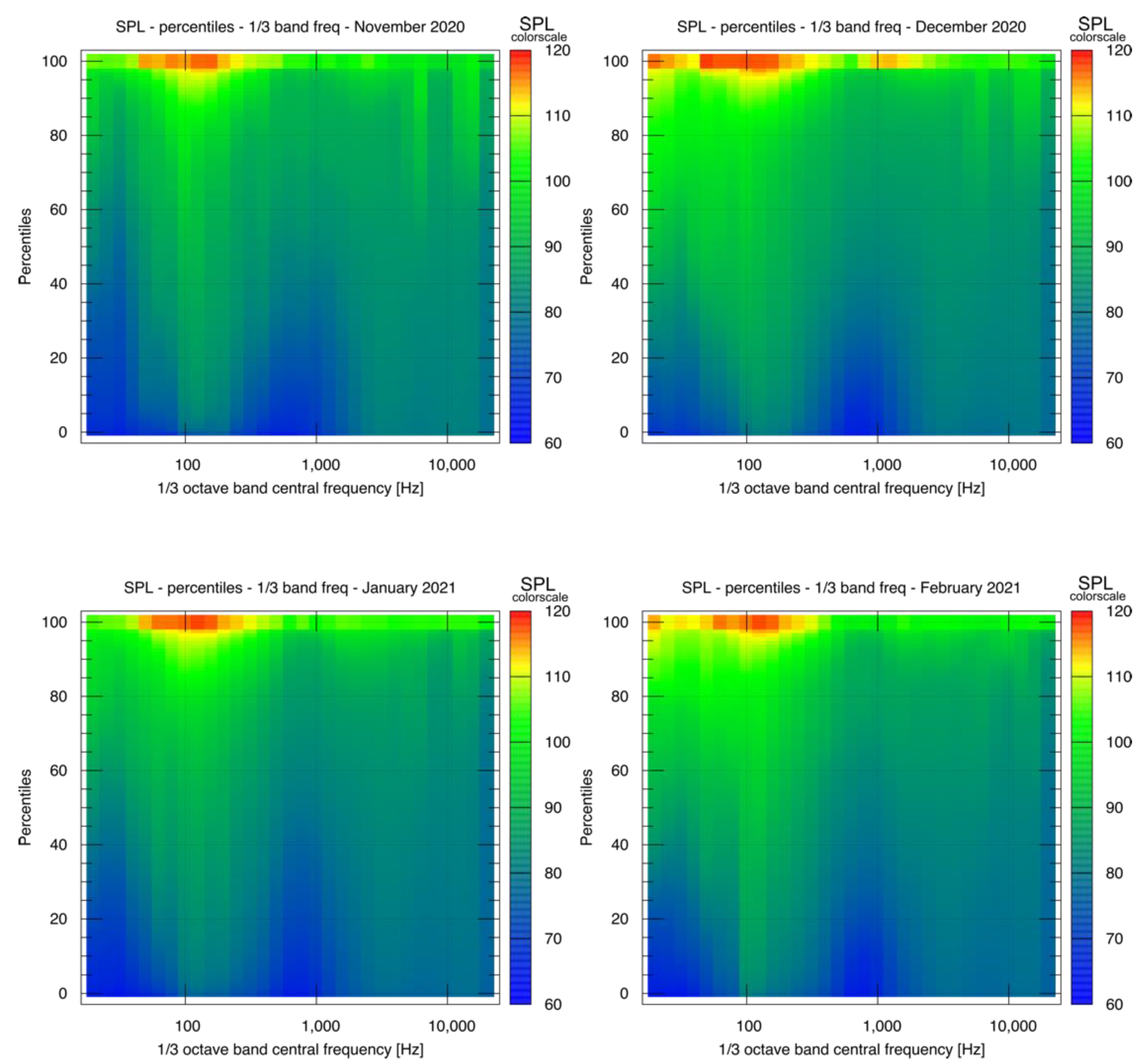

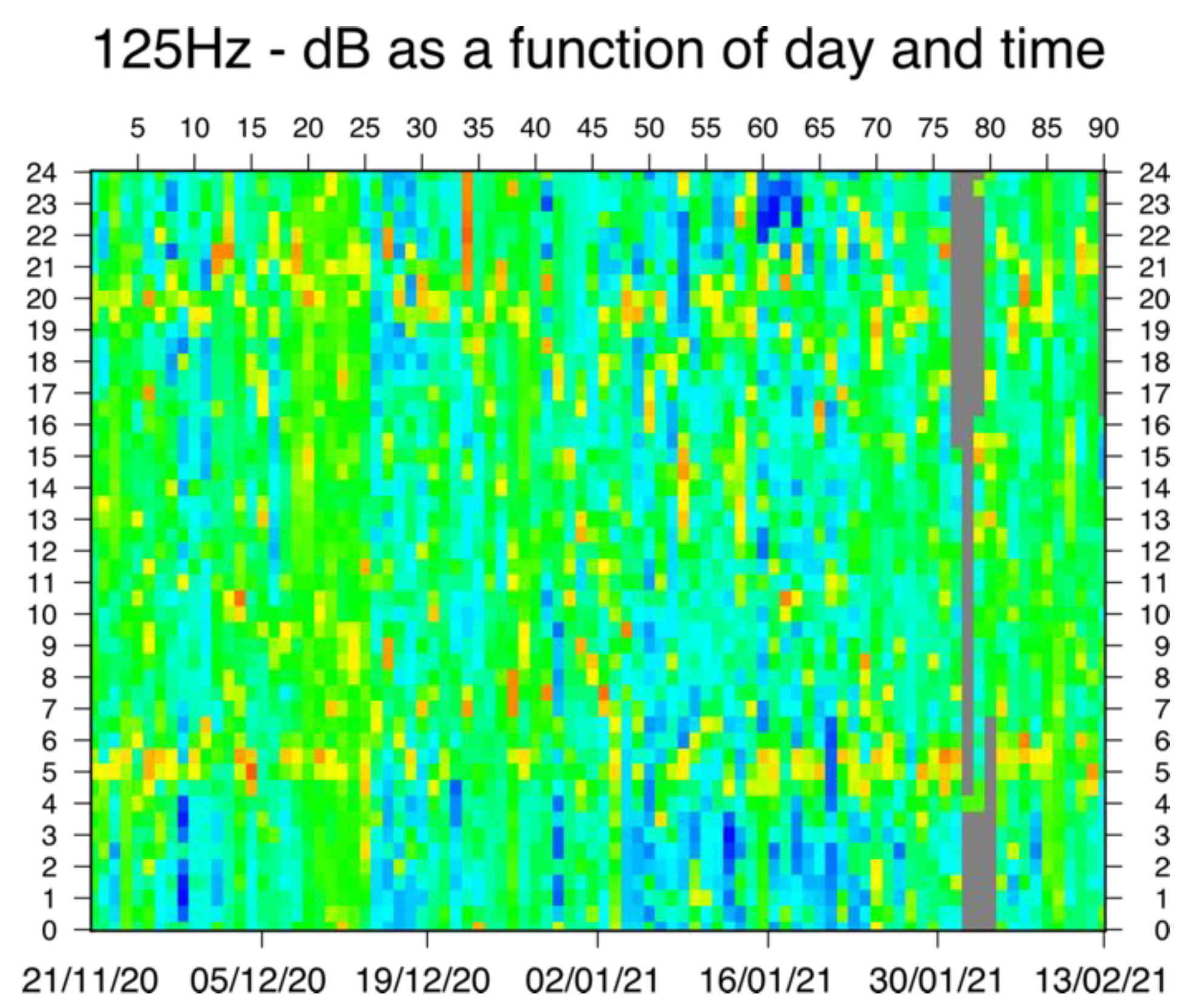

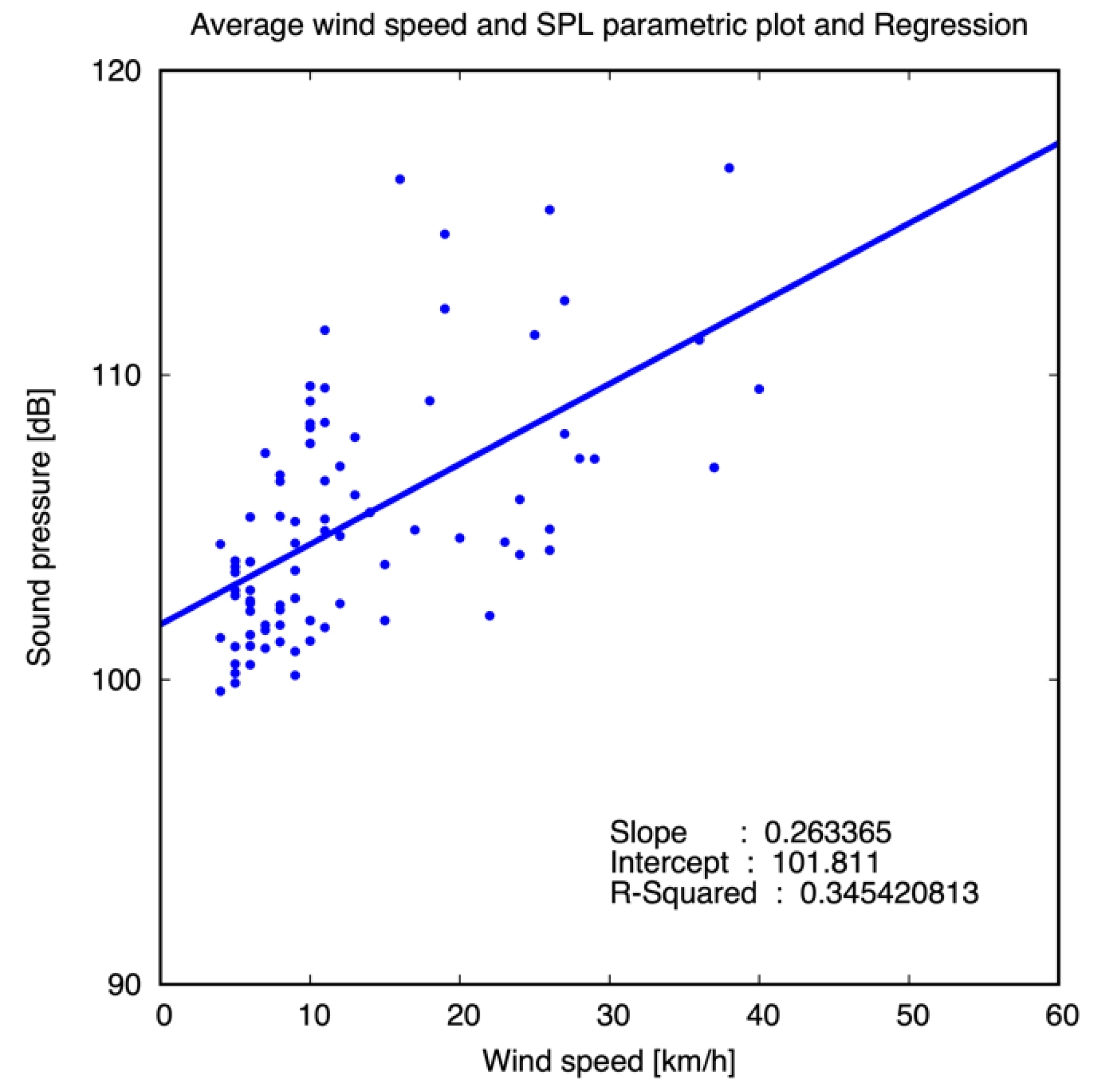
Publisher’s Note: MDPI stays neutral with regard to jurisdictional claims in published maps and institutional affiliations. |
© 2021 by the authors. Licensee MDPI, Basel, Switzerland. This article is an open access article distributed under the terms and conditions of the Creative Commons Attribution (CC BY) license (https://creativecommons.org/licenses/by/4.0/).
Share and Cite
Diviacco, P.; Nadali, A.; Iurcev, M.; Burca, M.; Carbajales, R.; Gangale, M.; Busato, A.; Brunetti, F.; Grio, L.; Viola, A.; et al. Underwater Noise Monitoring with Real-Time and Low-Cost Systems, (The CORMA Experience). J. Mar. Sci. Eng. 2021, 9, 390. https://doi.org/10.3390/jmse9040390
Diviacco P, Nadali A, Iurcev M, Burca M, Carbajales R, Gangale M, Busato A, Brunetti F, Grio L, Viola A, et al. Underwater Noise Monitoring with Real-Time and Low-Cost Systems, (The CORMA Experience). Journal of Marine Science and Engineering. 2021; 9(4):390. https://doi.org/10.3390/jmse9040390
Chicago/Turabian StyleDiviacco, Paolo, Antonio Nadali, Massimiliano Iurcev, Mihai Burca, Rodrigo Carbajales, Matteo Gangale, Alessandro Busato, Fabio Brunetti, Lorenzo Grio, Alberto Viola, and et al. 2021. "Underwater Noise Monitoring with Real-Time and Low-Cost Systems, (The CORMA Experience)" Journal of Marine Science and Engineering 9, no. 4: 390. https://doi.org/10.3390/jmse9040390
APA StyleDiviacco, P., Nadali, A., Iurcev, M., Burca, M., Carbajales, R., Gangale, M., Busato, A., Brunetti, F., Grio, L., Viola, A., & Potleca, N. (2021). Underwater Noise Monitoring with Real-Time and Low-Cost Systems, (The CORMA Experience). Journal of Marine Science and Engineering, 9(4), 390. https://doi.org/10.3390/jmse9040390







